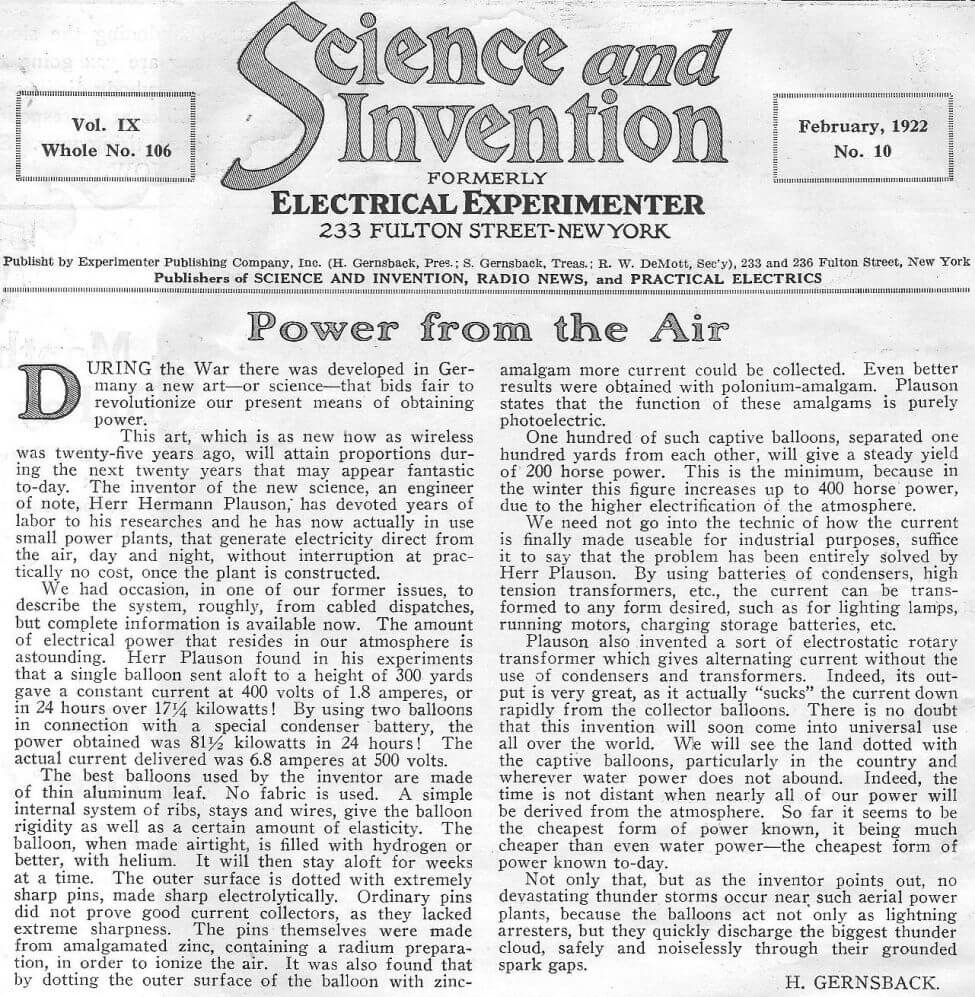Science and Invention, formerly Electrical Experimenter
An article about Plauson’s invention: a system that will deliver current that can be used for industrial purposes.

During the War there was developed in Germany a new art – or science — that bids fair to revolutionize our present means of obtaining power.
This art, which is as new now as wireless was twenty-five years ago, will attain proportions during the next twenty years that may appear fantastic today. The inventor of the new science, an engineer of note, Herr Hermann Plauson, has devoted years of labor to his researches and he has now actually in use small power plants, that generate electricity direct from the air, day and night, without interruption at practically no cost, once the plant is constructed.
We had occasion, in one of our former issues, to describe the system, roughly, from cabled dispatches, but complete information is available now. The amount of electrical power that resides in our atmosphere is astounding. Herr Plauson found in his experiments that a single balloon sent aloft to a height of 300 yards gave a constant current at 400 volts of 1.8 amperes, or in 24 hours over 171/4 kilowatts! By using two balloons in connection with a special condenser battery, the power obtained was 811/2 kilowatts in 24 hours! The actual current delivered was 6.8 amperes at 500 volts.
The best balloons used by the inventor are made of thin aluminum leaf. No fabric is used. A simple internal system of ribs, stays and wires, give the balloon rigidity as well as a certain amount of elasticity. The balloon, when made airtight, is tilled with hydrogen or better, with helium. It will then stay aloft for weeks at a time. The outer surface is dotted with extremely sharp pins, made sharp electrolytically. Ordinary pins did not prove good current collectors, as they lacked extreme sharpness. The pins themselves were made from amalgamated zinc, containing a radium preparation, in order to ionize the air. It was also found that by dotting the outer surface of the balloon with zinc-amalgam more current could be collected. Even better results were obtained with polonium-amalgam. Plauson states that the function of these amalgams is purely photoelectric.
One hundred of such captive balloons, separated one hundred yards from each other, will give a steady yield of 200 horse power. This is the minimum, because in the winter this figure increase, r.p to 400 horse power, due to the higher electrification of the atmosphere.
We need not go into the technic of how life current is finally made useable for industrial purposes, suffice it to say that the problem has been entirely solved by Herr Plauson. By using batteries of condensers, high tension transformers, etc., the current can be transformed to any form desired, such as for lighting lamps, running motors, charging storage batteries, etc. Plauson also invented a sort of electrostatic rotary transformer which gives alternating current without the use of condensers and transformers. Indeed, its output is very great, as it actually “sucks” the current down rapidly from the collector balloons. There is no doubt that this invention will soon come into universal use all over the world. We will see the land dotted with the captive balloons, particularly in the country and wherever water power does not abound. Indeed, the time is not distant when nearly all of our power will be derived from the atmosphere. So far it seems to be the cheapest form of power known, it being much cheaper than even water power—the cheapest form of power known to-day.
Not only that, but as the inventor points out, no devastating thunder storms occur near such aerial power plants, because the balloons act not only as lightning-arresters, but they quickly discharge the biggest thunder cloud, safely and noiselessly through their grounded spark gaps.









